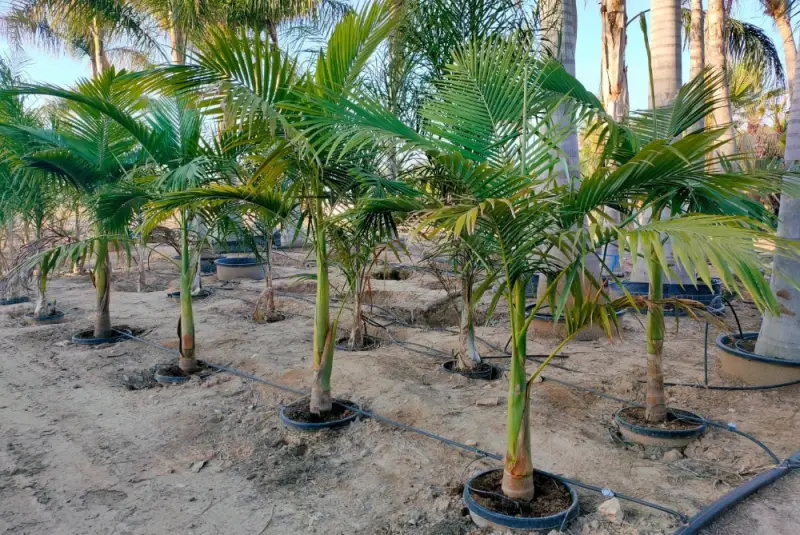The King Palm Tree, scientifically known as Archontophoenix cunninghamiana, is a stunning tropical palm celebrated for its lush, towering appearance. This elegant palm, native to the coastal rainforests of eastern Australia, thrives in warm, humid climates and adds a touch of exotic beauty to landscapes and gardens. While often grown outdoors, the King Palm can also be nurtured as an indoor houseplant when young, making it a versatile addition to any plant lover’s collection.
In this comprehensive King Palm care and growing guide, we’ll cover everything from lighting, watering, and soil requirements to propagation methods and pest control, ensuring your King Palm Tree remains healthy and vibrant for years.
Quick Facts About the King Palm Tree

- Scientific Name: Archontophoenix cunninghamiana
- Common Names: King Palm, Alexandra Palm, Alexander Palm
- Origin: Native to Queensland and New South Wales, Australia
- Growth Rate: Fast-growing, reaching heights of up to 40 feet and widths of 10-15 feet
- Cold Tolerance: Suitable for USDA Zones 9b (25-30°F) to 11 (above 40°F)
- Light Requirements: Partial shade to full sun
- Water Requirements: Moderate to high, depending on growth stage
- Soil Requirements: Adaptable, but prefers well-draining soil
- Propagation: By seeds, with germination in 2-3 months
- Fruits: Bright red, berry-like, not edible
King Palm Appearance
The King Palm stands out with its smooth, slender, gray-brown trunk that displays scars from fallen fronds. The base of the trunk is slightly swollen, adding a unique texture to its appearance. At the top of the trunk is a crownshaft—a green, cylindrical structure from which the fronds emerge.
The King Palm Tree’s foliage is lush and vibrant, featuring 15-20 arching, evergreen fronds that create a full crown. Each frond is composed of 100-150 narrow, bright green leaflets that add a soft, feathery effect to the tree’s overall look. The leaflets measure approximately 6-12 inches long, and their undersides may display brown scales.
Flowers and Fruits of the King Palm
In mid-summer, the King Palm produces clusters of pink flowers that add seasonal interest and fragrance to the tree. These flowers, located below the crownshaft, are arranged on branched inflorescences reaching 2-3 feet in length. Each inflorescence contains both male and female flowers, allowing the tree to self-pollinate.
After blooming, the King Palm develops small, berry-like fruits that turn from green to vibrant red when ripe. These non-edible fruits cluster together and are around ½ inch in diameter. Although not consumable, these bright fruits add an attractive ornamental feature to the tree.
How to Grow and Care for King Palm Trees
Light Requirements
The King Palm Tree prefers partial shade to full sun. Young palms should be placed in partial shade, as too much direct sunlight can scorch their fronds. As they mature, King Palms adapt well to full sun and will thrive in open spaces with plenty of light. Indoors, position them near a sunny window where they can receive indirect sunlight for at least 4-6 hours daily.
Soil Requirements
King Palms are highly adaptable to different soil types, but they grow best in well-draining, fertile soil with a slightly acidic to neutral pH (6.0-7.5). When planting outdoors, enrich sandy or clay soil with organic matter to improve its moisture retention and nutrient profile. Indoors, use a high-quality potting mix designed for palms or other tropical plants.
Water Requirements
Proper watering is essential for the health and growth of your King Palm:
- Young Trees: Water regularly to keep the soil consistently moist but avoid waterlogging, as excessive moisture can lead to root rot.
- Mature Trees: Once established, King Palms require moderate watering and can tolerate short periods of drought. Aim to water the tree every 7-10 days, adjusting based on rainfall and local climate conditions.
- Indoor King Palms: Water when the top inch of soil feels dry to the touch, being careful not to let the pot sit in standing water, which can cause root rot.
Fertilization
To maintain lush, green foliage and promote robust growth, apply a slow-release palm fertilizer twice a year during the growing season (spring and early summer). Look for a balanced fertilizer with micronutrients such as magnesium and potassium, which are essential for healthy, vibrant fronds. Avoid excessive fertilization, as this can lead to nutrient burn.
Pruning and Maintenance
Routine pruning helps maintain the King Palm’s appearance and health by removing dead or damaged fronds.
- Prune Sparingly: Only remove fronds that are completely brown or yellowed, as cutting green fronds can stress the tree.
- Timing: Prune in late winter or early spring to allow the tree to direct its energy towards new growth.
- Sterilize Tools: Use clean, sterilized pruning shears to prevent the spread of disease.
Cold Tolerance and Protection
The King Palm Tree is hardy in USDA Zones 9b to 11, tolerating temperatures as low as 25°F, though prolonged exposure to cold can damage young palms. In regions with colder winters, King Palms should be planted in sheltered areas or grown in containers that can be brought indoors during cold weather. Cover outdoor King Palms with frost cloth or burlap on particularly cold nights to protect them from frost.
Pests and Diseases
While generally resilient, King Palms can encounter common pests and diseases:
Pests
- Spider Mites: These small pests can cause yellowing and browning of leaves. Use insecticidal soap or neem oil to control infestations.
- Scale Insects: These sap-sucking pests can weaken the tree. Remove them manually or treat them with horticultural oil.
Diseases
- Leaf Spot: Caused by fungal pathogens, leaf spot can create brown or black spots on fronds. Improve air circulation and avoid overhead watering to prevent its spread.
- Root Rot: Caused by poor drainage, root rot can be fatal if not addressed. Ensure your soil drains well and water only as needed.
Propagation of King Palm Trees
The King Palm is propagated by seeds, which germinate within 2-3 months. Here’s a step-by-step guide to propagating this palm:
- Collect Fresh Seeds: Choose ripe, red fruits and remove the seeds.
- Soak Seeds: Soak seeds in warm water for 24 hours to soften their outer coating.
- Planting: Place seeds in a well-draining potting mix, covering them lightly with soil.
- Watering: Keep the soil consistently moist and warm (70-85°F) to encourage germination.
- Wait for Germination: Seeds typically germinate within 6 weeks to 3 months.
Growing King Palms Indoors
For indoor growers, King Palm Trees provide a tropical feel to home decor and are relatively easy to maintain. Place indoor King Palms in a location that receives bright, indirect light and rotate the plant periodically to ensure even growth. Humidity levels should be kept high, especially in dry climates; misting the leaves or using a humidifier can help. Repot the tree every 2-3 years to accommodate root growth and refresh the potting soil.
Benefits of Growing a King Palm Tree
The King Palm Tree offers several benefits:
- Aesthetic Appeal: Its elegant fronds and tall stature make it a focal point in gardens and indoor spaces.
- Air Purification: Like many palms, the King Palm helps purify the air by removing toxins.
- Wildlife Attraction: Outdoors, its flowers attract pollinators, while its dense foliage provides habitat for birds.
Conclusion
The King Palm Tree (Archontophoenix cunninghamiana) is a truly majestic tree that, with proper care, can thrive in various climates, from subtropical landscapes to indoor environments. By following this detailed King Palm care and growing guide, you’ll ensure your tree remains healthy, vibrant, and a magnificent addition to your home or garden. Embrace the beauty of this tropical palm and enjoy the elegance and charm it brings to your space.






